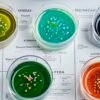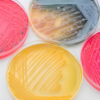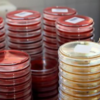
Plant tissue culture media serve as artificial ecosystems where single cells transform into entire plants. This technology underpins 78% of modern crop improvement programs, enabling disease-free propagation, genetic engineering, and species conservation. With global food demand projected to increase by 56% by 2050, optimized media formulations accelerate the development of resilient crops.
Core Media Components & Functions
| Component | Critical Role | Innovative Formats |
|---|---|---|
| Macronutrients | N-P-K base for cellular structure | Chelated iron for bioavailability |
| Growth Regulators | Control organogenesis (auxins/cytokinins) | Time-release hormone beads |
| Carbon Sources | Energy supply (sucrose/glucose) | Starch polymers for slow release |
| Gelling Agents | Structural support (agar/gellan) | Phytagel™ alternatives |
| Stress Protectants | Reduce oxidative damage | Nanoparticle-enabled antioxidants |
Genetic Research Applications
- CRISPR-Cas9 Integration
- Selection media with kanamycin/hygromycin markers
- Transient expression boosters for higher editing efficiency
- Protoplast Isolation
- Enzyme cocktails (cellulase/pectinase) in osmoticum media
- Viability preservation: >90% membrane integrity
- Somatic Embryogenesis
- Bipolar development media with ABA/JA hormones
- Maturation rate: 3x faster than zygotic embryos
Species-Specific Formulations
Orchids:
- Banana homogenate substitutes for asymbiotic germination
- Dark-phase media with activated charcoal
Cereals:
- High-auxin media for scutellum-derived callus
- Silver nitrate additives to prevent ethylene damage
Endangered Species:
- Cryopreservation media with DMSO/sucrose gradients
- Vitrification solutions for liquid nitrogen storage
Sterilization & Preparation Protocol
1. **Dry Media Preparation**- Pre-weighed powder mixes (pH-adjusted)- Gamma-irradiated packaging2. **Autoclaving Parameters**- 121°C for 20 minutes (carryover <1%)- Avoid carbohydrate caramelization3. **Aseptic Transfer**- Laminar flow hood protocols- Antibiotic cocktails for contamination control
Troubleshooting Guide
| Issue | Media Solution | Success Rate |
|---|---|---|
| Browning | Polyvinylpyrrolidone additives | 89% reduction |
| Hyperhydricity | Increased agar concentration | 95% correction |
| Low regeneration | Cytokinin-optimized formulations | 3.2x improvement |
| Microbial contamination | Antibiotic-embedded media | 99.7% sterile |
Innovations Redefining the Field
- Smart Media
- pH-responsive color indicators
- Nutrient-release sensors
- Hybrid Delivery Systems
- Encapsulated hormones in nanofibers
- Root-targeted nutrient microbeads
- Automated Platforms
- Robotic media dispensing systems
- AI-driven growth optimization
Validation & Quality Control
- Growth Metrics:
- Shoot multiplication coefficient (SMC) >5.0
- Rooting efficiency >85%
- Genetic Fidelity:
- ISSR marker verification (98% uniformity)
- Ploidy stability checks
Sustainability Advantages
- Resource Efficiency:
- 92% less water than traditional propagation
- 65% reduced pesticide use
- Material Innovation:
- Plant-based gelling agents
- Biodegradable culture vessels
Implementation Roadmap
- Media Selection Matrix:
- Match species to base formulations (MS/B5/N6)
- Customize growth regulator ratios
- Climate Adaptation:
- Temperature-resilient media (15-30°C stability)
- Low-light optimization additives
- Scalability Planning:
- Liquid media for bioreactors
- Automated subculture protocols
Conclusion: Cultivating the Future
Plant tissue culture media have evolved from simple nutrient solutions to precision bioengineering platforms. By mastering the biochemical language of plant cells – from auxin gradients to osmotic balances – researchers unlock unprecedented control over growth and genetic expression. As climate resilience and food security dominate agricultural science, these media transform laboratories into innovation engines where microscopic tissues yield macroscopic solutions.
Recent Posts
- Breaking Down the Role of Culture Media in Pharmaceutical Research
- A Guide to Using Culture Media for Strict European Cosmetic Safety Compliance
- The Role of Culture Media in Ensuring Accurate Cosmetic Microbial Testing
- Transport Media and Their Role in Microbial Sample Transport
- How Culture Media Impact the Precision of Cosmetic Microbial Testing



